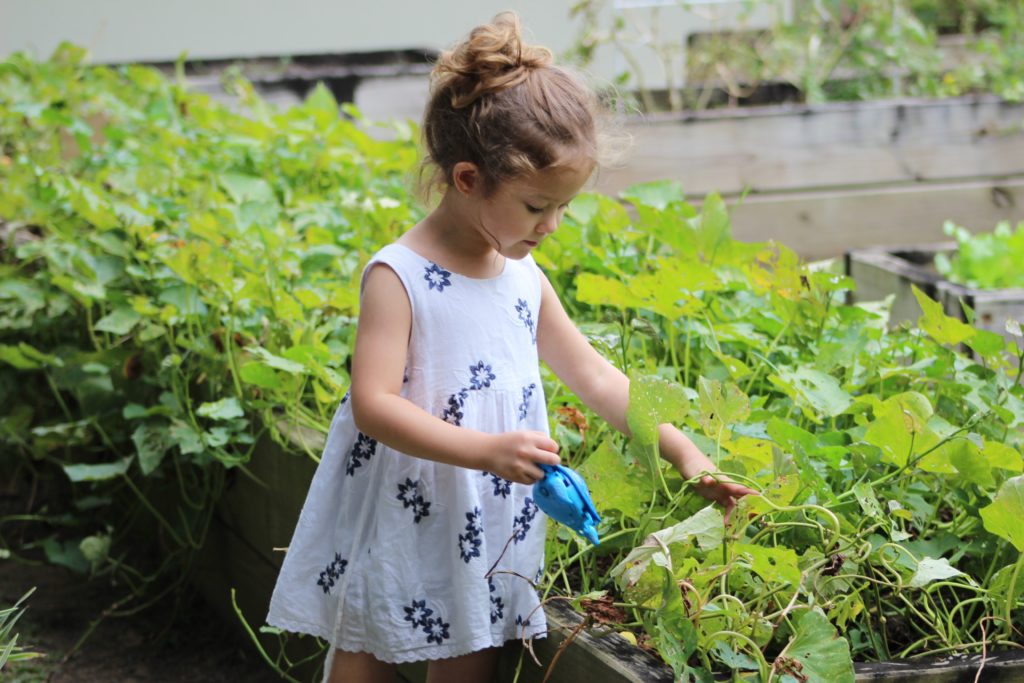Are you looking for a fun and easy way to connect with your child, get some light exercise and fresh air, and enjoy delicious and healthy food? Gardening with kids can be simple, playful, and productive. It’s also highly adaptable to your space, physical abilities, and interests – and spring is the perfect time to get started!
An invitation to dig in the dirt is usually all you need to convince your child to join you in the garden. If your child needs a little more inspiration, there are many age-appropriate books to check out. Kevin Henke’s My Garden for the youngest gardeners, The Curious Garden by Peter Brown for elementary age children, and the chapter book The Year of the Garden by Andrea Chang are solid choices.
Once your child is on board, it’s time to make a garden plan. This can be as simple as a conversation about what your child would like to grow or as elaborate as studying gardening catalogs and drawing plans together. If this is a new endeavor for you, I recommend keeping your garden plan simple.
Consider where your garden will be located. Ideally, it is near your house and a water source, and receives adequate sunlight for at least eight hours a day. If you can locate your growing area near your child’s outdoor play space, even better. If that isn’t possible, you might plan on adding a playful element to your garden space like a sandbox or mud kitchen to increase the likelihood that your child will spend time there.
Where you plant will depend on available space, access to gardening tools, and your own mobility and comfort needs. Gardening in containers will allow for less bending and kneeling and won’t require strenuous tilling or construction of raised beds. Be creative and resourceful: an old plastic storage container with a missing lid can have a second life as a container garden. Just add some holes for drainage and fill with a growing medium formulated for containers.
Here are some considerations when deciding what to plant:
What grows quickly?
If your child can see results from their efforts sooner than later, their interest in gardening will likely be sustained. Greens like lettuce and chard, radishes, and beets are quick to grow and perfect for spring planting.
What does your child like to eat?
Potatoes are almost universally loved by children and easy to grow, even in containers. Strawberries take a few years to produce, but the sweet results are well worth the wait. If pizza is a favorite, consider growing ingredients to make your own: tomatoes, basil, oregano, and peppers.
What will delight the senses?
Your child’s garden can easily include elements to engage all the senses. Nasturtiums are simple to grow from seed and have brightly colored flowers that also happen to be edible. Herbs release aromas when they are handled, so including rosemary, basil, lavender, and other culinary herbs will provide tactile, aromatic, and tasty results. A simple wind chime will offer a welcoming sound to your garden space.
Enhance the experience with garden-related crafts like making plant labels, crafting seed packets for the seeds you harvest at the end of the growing season, or building a fairy garden for a touch of magic. Children never seem to tire of making mud pies and potions, and all the necessary elements are at the ready in the garden. Try making tea from your homegrown herbs or create a treasure hunt with simple trinkets and a map.
A picnic table will make your garden a destination for summertime snacking and crafting. Shade from a tree or umbrella will be a welcome retreat on a hot day. Don’t forget to add a comfy chair to your garden space! You’ll want to take breaks while you’re tending the plants, and you might find that it becomes a favorite spot for reading, cuddling, and dreaming.
A final word of advice: as an early childhood educator, an enduring mantra is “process over product.” Remember that even if all you harvest from your garden is weeds, you’ll create lasting memories and instill a love of the natural world with your child. These are gifts you’ll never find at your local grocery store. Happy gardening!
Resources:
Brown, Peter. The Curious Garden. Little, Brown, 2009
Cheng, Andrea. The Year of the Garden. Houghton Mifflin Harcourt, 2017.
Henkes, Kevin. My Garden. HarperCollins, 2010.

